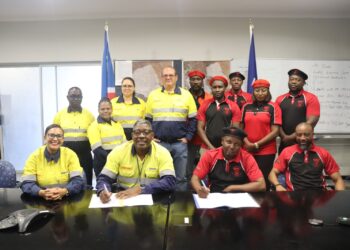
Namibia Power Corporation (NamPower) says the Omburu Battery Energy Storage System (BESS) project to be constructed at Omaruru will alleviate the country’s dependency on Eskom, which currently provides ancillary and emergency services.
NamPower’s Managing Director Simson Kahenge Haulofu said the BESS will be used to facilitate, support and preserve power quality in the electricity grid, by providing ancillary services such as reactive, voltage and ramp rate control.
“The BESS will also have the functionality to perform frequency control which is a service currently being provided by Eskom,” said Haulofu.
Haulofu said this on Wednesday at the signing of a contractual agreement with Shandong Electrical, Engineering and Equipment Group Co. Ltd and Zhejiang Narada Power Source Co., Ltd JV, for the development of Omburu BESS with a capacity of 54MW.
The project is grant funded through the KfW Development Bank to the value of N$400 million.
Construction is set to begin between February and March next year, within 18 months.
Its life circle is pegged at 10 years, but can also extend up to 19 years depending on the charging and discharge.
On its part, the national power utility set aside an investment of N$100 million towards the construction of the transmission interconnection, technical advisory, project management and an owner’s engineer.
Furthermore, Haulofu said the Omburu BESS will alleviate challenges posed by under forecasting the energy demand which currently leads to sourcing of expensive emergency energy from Eskom or the Southern African Power Pool (SAPP).
“This project will play a pivotal role by mitigating the impact of under forecasting by offering rapid and responsive energy supply. While from our national centre, the BESS will be able to immediately address the gap between the actual and forecasted demands,” he said.
In addition, the development will reduce reliance on expensive peaking plants and imports, as NamPower will be able to manage energy demand during off-peak times and discharging periods during peak times.
The project is part of NamPower’s five-year strategic plan, in which it aims to increase its renewable energy generation by 100MW by 2025.
By 2030, it targets to increase the share of renewable energy generation from 30% to 70%, which is likely to reduce the high dependency on electricity imports, while further promoting self-sufficiency.
Currently, Namibia has a power generation capacity of up to 486MW, while the national energy demand is over 600MW per annum.
Meanwhile, the contractor representative, Benny Jin promised that the companies will construct a high-end power station by providing first-class technology and scientific management.
KfW Director for Namibia, Beatrice Lucke, said Namibia still has a long way to go in developing its renewable sector as more work and investments lie ahead.
“Therefore, we believe the BESS project together with NamPower’s renewable endeavour will offset fossil fuel use at existing NamPower coal plants. We however take note that, clean energy is the future globally but it comes with its challenges of energy generation fluctuation from wind and solar,” said Lucke.
In addition to this, the National Planning Commission Executive Director, Wilhencia Uiras, said it is a pivotal step in achieving the national energy goals.-miningandenergy.com.na











